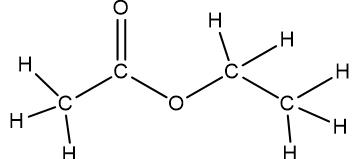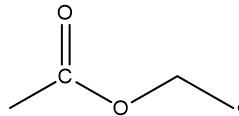
Introduction To Chemistry
5th Edition
ISBN: 9781259911149
Author: BAUER, Richard C., Birk, James P., Marks, Pamela
Publisher: Mcgraw-hill Education,
expand_more
expand_more
format_list_bulleted
Concept explainers
Question
Chapter 16, Problem 14QP
(a)
Interpretation Introduction
Interpretation:
The structural formula and the line structure of the given ball and stick model is to be drawn.
(b)
Interpretation Introduction
Interpretation:
The structural formula and the line structure of the given ball and stick model is to be drawn.
(c)
Interpretation Introduction
Interpretation:
The structural formula and the line structure of the given ball and stick model is to be drawn.
Explanation:
Consider the given ball and stick model. The black balls represent carbon atoms and the grey balls represent hydrogen atoms. Thus, the structural formula is,

The line structure for the above molecule is,

Expert Solution & Answer
Want to see the full answer?
Check out a sample textbook solution
Students have asked these similar questions
Use the data below from an electron impact mass spectrum of a pure compound to deduce its structure. Draw your structure in the
drawing window.
Data selected from the NIST
WebBook,
https://webbook.nist.gov/chemistry/
m/z
Relative intensity
31
0.5
30
26
29
22
28
100
27
33
26
23
15
4
• You do not have to consider stereochemistry.
You do not have to explicitly draw H atoms.
• In cases where there is more than one answer, just draw one.
妊
n
?
Previous
Next
for this question.
Write the molecular formula for a compound with the possible elements C, H, N and O that exhibits a molecular ion at M+ = 98.1106.
Exact Masses of the Most Abundant Isotope of
Selected Elements
Isotope Natural abundance (%) Exact mass
1H
99.985
1.008
12C
98.90
12.000
14N
99.63
14.003
160
99.76
15.995
Molecular formula
(In the order CHNO, with no subscripts)
PLEASE READ!!! I DONT WANT EXAMPLES, I DONT WANT WORDS OR PARAGRAPHS!!! PLEASE I UNDERSTAND THE BASICS BUT THIS IS AN EXCEPTION THAT EVEN THE INTERNET CANT HELP!!!!
THIS IS THE THIRD TIME I'VE SENT THOSE QUESTIONS SO PLEASE DONT RESEND THE SAME STUFF, ITS NOT HELPING ME!!!
I ALSO ALREADY TRIED TO DRAW THE MECHANISM MYSELF, SO IF ITS RIGHT PLEASE TELL ME OR TELL ME WHAT I HAVE TO CHANGE!!!
First image: I have to SHOW (DRAWING) the mechanism (with arows and structures of molecules) NOT WORDS PLEASE! of the reaction at the bottom. Also I have to show by mecanism why the reaction wouldn't work if the alcohol was primary
Second image: I have to show the mechanism (IMAGE) (with arrows and structures of the molecules) NOT WORDS PLEASE !! for the reaction on the left, where the alcohol A is added fast in one portion
HOMEWORK, NOT EXAM!!
ALL DETAILS ARE IN THE IMAGES PLEASE LOOK AT THE IMAGES, DONT LOOK AT THE AI GENERATED TEXT!!!
Chapter 16 Solutions
Introduction To Chemistry
Ch. 16 - Prob. 1QCCh. 16 - Prob. 2QCCh. 16 - Prob. 3QCCh. 16 - What are cyclic hydrocarbons, and how do they...Ch. 16 - Prob. 5QCCh. 16 - Prob. 6QCCh. 16 - Prob. 7QCCh. 16 - Prob. 8QCCh. 16 - Prob. 9QCCh. 16 - Prob. 1PP
Ch. 16 - Prob. 2PPCh. 16 - Prob. 3PPCh. 16 - Prob. 4PPCh. 16 - Prob. 5PPCh. 16 - Prob. 6PPCh. 16 - Prob. 7PPCh. 16 - Prob. 8PPCh. 16 - Prob. 9PPCh. 16 - Prob. 10PPCh. 16 - Prob. 11PPCh. 16 - Prob. 1QPCh. 16 - Prob. 2QPCh. 16 - Prob. 3QPCh. 16 - Prob. 4QPCh. 16 - Prob. 5QPCh. 16 - Prob. 6QPCh. 16 - Prob. 7QPCh. 16 - Prob. 8QPCh. 16 - Prob. 9QPCh. 16 - Prob. 10QPCh. 16 - Prob. 11QPCh. 16 - Prob. 12QPCh. 16 - Prob. 13QPCh. 16 - Prob. 14QPCh. 16 - Prob. 15QPCh. 16 - Prob. 16QPCh. 16 - Prob. 17QPCh. 16 - Prob. 18QPCh. 16 - Prob. 19QPCh. 16 - Prob. 20QPCh. 16 - Prob. 21QPCh. 16 - Prob. 22QPCh. 16 - Prob. 23QPCh. 16 - Prob. 24QPCh. 16 - Prob. 25QPCh. 16 - Prob. 26QPCh. 16 - Prob. 27QPCh. 16 - Prob. 28QPCh. 16 - Prob. 29QPCh. 16 - Prob. 30QPCh. 16 - Prob. 31QPCh. 16 - Prob. 32QPCh. 16 - Prob. 33QPCh. 16 - Prob. 34QPCh. 16 - Prob. 35QPCh. 16 - Prob. 36QPCh. 16 - Prob. 37QPCh. 16 - Prob. 38QPCh. 16 - Prob. 39QPCh. 16 - Prob. 40QPCh. 16 - Prob. 41QPCh. 16 - Write IUPAC names for the following compounds....Ch. 16 - Prob. 43QPCh. 16 - Prob. 44QPCh. 16 - Prob. 45QPCh. 16 - Prob. 46QPCh. 16 - Prob. 47QPCh. 16 - Prob. 48QPCh. 16 - Prob. 49QPCh. 16 - Prob. 50QPCh. 16 - Prob. 51QPCh. 16 - Prob. 52QPCh. 16 - Prob. 53QPCh. 16 - Prob. 54QPCh. 16 - Prob. 55QPCh. 16 - Prob. 56QPCh. 16 - Prob. 57QPCh. 16 - Prob. 58QPCh. 16 - Prob. 59QPCh. 16 - Prob. 60QPCh. 16 - Prob. 61QPCh. 16 - Prob. 62QPCh. 16 - Prob. 63QPCh. 16 - Prob. 64QPCh. 16 - Prob. 65QPCh. 16 - Prob. 66QPCh. 16 - Prob. 67QPCh. 16 - Prob. 68QPCh. 16 - Prob. 69QPCh. 16 - Prob. 70QPCh. 16 - Prob. 71QPCh. 16 - Prob. 72QPCh. 16 - Prob. 73QPCh. 16 - Prob. 74QPCh. 16 - Prob. 75QPCh. 16 - Prob. 76QPCh. 16 - Prob. 77QPCh. 16 - Prob. 78QPCh. 16 - Prob. 79QPCh. 16 - Prob. 80QPCh. 16 - Prob. 81QPCh. 16 - Prob. 82QPCh. 16 - Prob. 83QPCh. 16 - Prob. 84QPCh. 16 - Prob. 85QPCh. 16 - Prob. 86QPCh. 16 - Prob. 87QPCh. 16 - Prob. 88QPCh. 16 - Predict and explain the relative boiling points of...Ch. 16 - Prob. 90QPCh. 16 - Prob. 91QPCh. 16 - Prob. 92QPCh. 16 - Prob. 93QPCh. 16 - Prob. 94QPCh. 16 - Prob. 95QPCh. 16 - Prob. 96QPCh. 16 - Prob. 97QPCh. 16 - Prob. 98QPCh. 16 - Prob. 99QPCh. 16 - Prob. 100QPCh. 16 - Prob. 101QPCh. 16 - Prob. 102QPCh. 16 - Prob. 103QPCh. 16 - Prob. 104QPCh. 16 - Prob. 105QPCh. 16 - Prob. 106QPCh. 16 - Prob. 107QPCh. 16 - Prob. 108QPCh. 16 - Prob. 109QPCh. 16 - Prob. 110QPCh. 16 - Prob. 111QPCh. 16 - Prob. 112QPCh. 16 - Prob. 113QPCh. 16 - Prob. 114QPCh. 16 - Prob. 115QPCh. 16 - Prob. 116QPCh. 16 - Prob. 117QPCh. 16 - Prob. 118QPCh. 16 - Prob. 119QPCh. 16 - Prob. 120QPCh. 16 - Prob. 121QPCh. 16 - Draw the line structures for the ether and two...Ch. 16 - Prob. 123QPCh. 16 - Prob. 124QPCh. 16 - Prob. 125QPCh. 16 - Prob. 126QPCh. 16 - Write structural formulas for all the isomers of...Ch. 16 - Prob. 128QPCh. 16 - Prob. 129QPCh. 16 - Prob. 130QPCh. 16 - Prob. 131QPCh. 16 - Prob. 132QPCh. 16 - Prob. 133QPCh. 16 - Prob. 134QPCh. 16 - Prob. 135QPCh. 16 - Prob. 136QPCh. 16 - Prob. 137QPCh. 16 - Prob. 138QPCh. 16 - Prob. 139QPCh. 16 - Prob. 140QPCh. 16 - Prob. 141QPCh. 16 - Prob. 142QPCh. 16 - Prob. 143QP
Knowledge Booster
Learn more about
Need a deep-dive on the concept behind this application? Look no further. Learn more about this topic, chemistry and related others by exploring similar questions and additional content below.Similar questions
- Write the molecular formula for a compound with the possible elements C, H, N and O that exhibits a molecular ion at M+ = 85.0899. Exact Masses of the Most Abundant Isotope of Selected Elements Isotope Natural abundance (%) Exact mass 1H 99.985 1.008 12C 98.90 12.000 14N 99.63 14.003 160 99.76 15.995 Molecular formula (In the order CHNO, with no subscripts)arrow_forwardUse the data below from an electron impact mass spectrum of a pure compound to deduce its structure. Draw your structure in the drawing window. Data selected from the NIST WebBook, https://webbook.nist.gov/chemistry/ m/z Relative intensity 59 3.0 58 64 43 100 15 23 • You do not have to consider stereochemistry. •You do not have to explicitly draw H atoms. • In cases where there is more than one answer, just draw one. + n[] 85 // ? CH4 Previous Nextarrow_forwardWrite the molecular formula for a compound with the possible elements C, H, N and O that exhibits a molecular ion at M* = 128.0632. Exact Masses of the Most Abundant Isotope of Selected Elements Isotope Natural abundance (%) Exact mass 1H 99.985 12C 98.90 14N 99.63 160 99.76 Molecular formula 1.008 12.000 14.003 15.995 (In the order CHNO, with no subscripts)arrow_forward
- Can I please get help with this? And can I please the lowest possible significant number?arrow_forwardWhat is the molar mass of a gas that takes three times longer to effuse than helium?arrow_forwardFirst image: I have to show the mecanism (with arows and structures) of the reaction at the bottom. Also I have to show by mecanism why the reaction wouldn't work if the alcohol was primary Second image: I have to show the mecanism (with arrows and structures) for the reaction on the left, where the alcohol A is added fast in one portion its not an examarrow_forward
- what is the skeletal structure of a tertiary alkyl fluoride with six carbon atoms and no rings.arrow_forwardOne step of glycolysis is a retro-aldol reaction (aldolase) to produce ATP.Below is the aldol reaction of the equilibrium. Show the mechanism for the base catalyzed reaction. *see imagearrow_forwardProvide the missing information. *see imagearrow_forward
arrow_back_ios
SEE MORE QUESTIONS
arrow_forward_ios
Recommended textbooks for you
 Introductory Chemistry: An Active Learning Approa...ChemistryISBN:9781305079250Author:Mark S. Cracolice, Ed PetersPublisher:Cengage Learning
Introductory Chemistry: An Active Learning Approa...ChemistryISBN:9781305079250Author:Mark S. Cracolice, Ed PetersPublisher:Cengage Learning Chemistry: Matter and ChangeChemistryISBN:9780078746376Author:Dinah Zike, Laurel Dingrando, Nicholas Hainen, Cheryl WistromPublisher:Glencoe/McGraw-Hill School Pub Co
Chemistry: Matter and ChangeChemistryISBN:9780078746376Author:Dinah Zike, Laurel Dingrando, Nicholas Hainen, Cheryl WistromPublisher:Glencoe/McGraw-Hill School Pub Co Living By Chemistry: First Edition TextbookChemistryISBN:9781559539418Author:Angelica StacyPublisher:MAC HIGHER
Living By Chemistry: First Edition TextbookChemistryISBN:9781559539418Author:Angelica StacyPublisher:MAC HIGHER World of Chemistry, 3rd editionChemistryISBN:9781133109655Author:Steven S. Zumdahl, Susan L. Zumdahl, Donald J. DeCostePublisher:Brooks / Cole / Cengage Learning
World of Chemistry, 3rd editionChemistryISBN:9781133109655Author:Steven S. Zumdahl, Susan L. Zumdahl, Donald J. DeCostePublisher:Brooks / Cole / Cengage Learning

Introductory Chemistry: An Active Learning Approa...
Chemistry
ISBN:9781305079250
Author:Mark S. Cracolice, Ed Peters
Publisher:Cengage Learning


Chemistry: Matter and Change
Chemistry
ISBN:9780078746376
Author:Dinah Zike, Laurel Dingrando, Nicholas Hainen, Cheryl Wistrom
Publisher:Glencoe/McGraw-Hill School Pub Co

Living By Chemistry: First Edition Textbook
Chemistry
ISBN:9781559539418
Author:Angelica Stacy
Publisher:MAC HIGHER


World of Chemistry, 3rd edition
Chemistry
ISBN:9781133109655
Author:Steven S. Zumdahl, Susan L. Zumdahl, Donald J. DeCoste
Publisher:Brooks / Cole / Cengage Learning